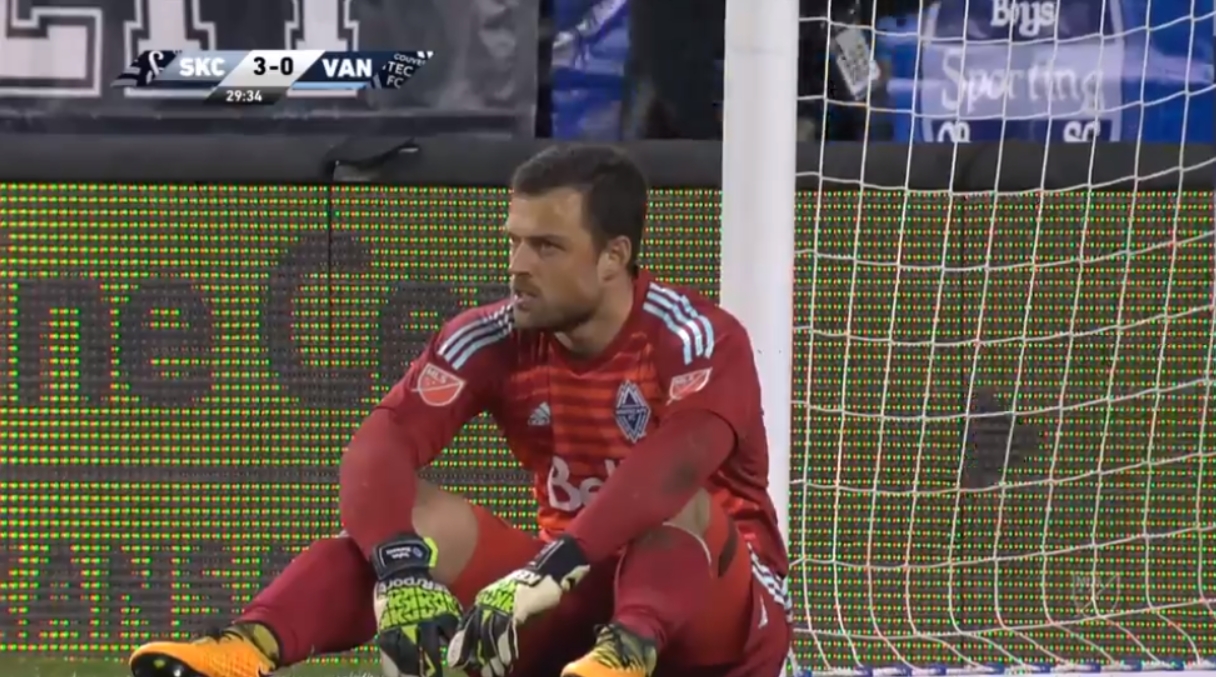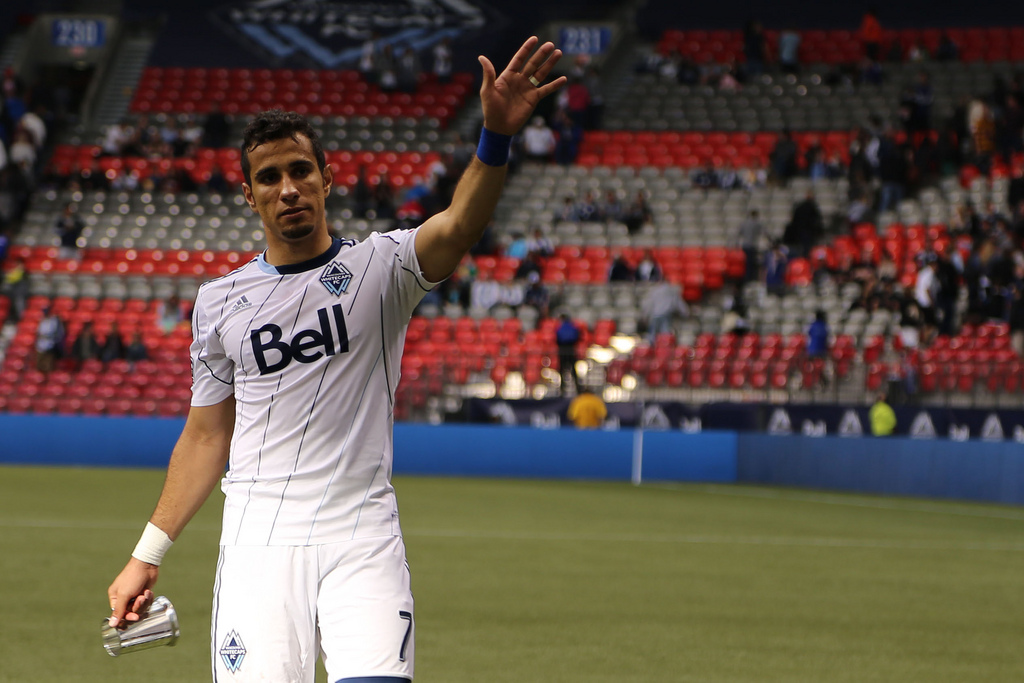
I’ve never seen Stephen Marinovic this furious, after the third goal, and he looks furious all the time. (Photo: MLS)
The thing is, soccer as we know it isn’t guaranteed. People complain about soccer being low-scoring, but it is actually the game’s biggest wonder: The goal is large. The pitch is vast. The ball goes fast, because kicks are powerful. The ball only stays out of the goal because of collective will and group effort; if the wheels fall off, there’s no limit to how many goals a team can concede. Which brings us to the Vancouver Whitecaps’ 6-0, nine-man loss to Sporting Kansas City.
The weirdest part about the Vancouver Whitecaps’ worst-ever MLS game is that it didn’t come in a dire campaign (yet) but one that started with a small amount of promise. But the team has had a number of weak spots and questionable decisions, and while there’s a lot you can cover for or equivocate if you make the wrong choices repeatedly and are not bailed out by luck, a systems failure like Friday’s can smack you on the nose.
The team’s slimmer-salary strategy always makes these discussions difficult, because it creates a push-and-pull where the club tries to promote new additions to a skeptical fanbase envious of the star-studded acquisitions made by teams around the league. But while a Schweinsteiger or a Zlatan would certainly be nice, the Whitecaps’ issue has been a lack of continuity and cohesion. When the team lost talismans David Ousted and Jordan Harvey in the offseason and a bevy of other players, one of my worries was, how much turnover is insurmountable? How much change is too much? In such a situation, a solid preseason is invaluable.
Of course, three days before the season began, the Whitecaps traded away starting centreback Tim Parker for defensive midfielder Felipe Martins. Parker delivered three years of excellent service far exceeding his contract; he then demanded a raise higher than the club would bear. (Kristian Dyer reported he turned down $1.4 million over three years, a lot for a defender in this league.) It probably couldn’t have been helped, but it threw the team off balance in two key ways. It forced Jose Aja and Aaron Maund, alternately, to shoulder the burden of a starting lineup spot on defense, and it forced manager Carl Robinson to find a place for Felipe beside his coveted acquisition Efrahim Juarez, which my podcast pal Nick Thornton has suggested negates both. Aja and Maund, though not awful, have been only serviceable in a starting role, and neither has the chemistry with captain Kendall Waston on the backline that Parker was able to find.
But even then, all was not lost. Kei Kamara turned out to be an excellent talisman player that was able to take a leadership position and help bind the team together. The Whitecaps have won each of the games in which he scored, and none of the others. He was dropped from last week’s loss against LAFC with an adductor strain that also kept him out here and will likely keep him off the sheet for the next match against Real Salt Lake, who handled the Whitecaps easily not three weeks ago. Despite the cracks forming in the Whitecaps lineup, Kamara’s passion helped tie everything together and was a vindication of the club’s bargain buy approach. Without him, the team’s play has lacked fire for three straight weeks.
Perhaps the final straw, and the mistake most attributable to Robinson, is the decision to use a 3-5-2 formation. Robinson has been dismissive of obsessing over one formation versus another in past seasons, but put out a lot of signs he was considering a switch to the 3-5-2 in preseason. However, when the team took to the pitch, it only lined up that way for one half of a friendly, and then in the season itself only in the 4-1 loss to Atlanta. (Which, if you add to this game before the red cards, makes a -6 goal difference over 120-odd minutes of play.) The idea is that you use three centrebacks, and then you use two midfielders that drop down to add defensive muscle out wide. Here’s how that went, from Kansas City’s first goal, nine minutes in:

Committing those wingbacks leaves the central midfield exposed, which was exploited by a pass Aly Ghazal tried to break his lungs to prevent, while the closer midfielder, Felipe watched at a trot. In the second goal, Waston and Nerwinski collapse onto each others’ positions and can’t stop Johnny Russell’s shot. The third goal was a wonder, made possible by the fact that six Whitecaps were lying back as opposed to pressing Jimmy Medranda. All this puts so much pressure on Waston to perform, which he did not, and his heightened tension sets the stage for the wild conflagration that made this game unwinnable.
Waston fouls Roger Espinoza, but feels like maybe he didn’t (wrong) so he marches over to insincerely help up his opponent, bringing several SKC players in like a hurricane. In the resulting melee, Yordy Reyna and Juarez both get reds for lashing out at Russell, and I could continue to analyze the 9-man, 4-3-1 formation’s three ensuing goals, but I won’t. The previous club record for losing margin was four, the league record was seven, and if it wasn’t for goalkeeper Stephen Marinovic, it could have been nine, including a saved penalty.
The key point to make here is a counterpoint to Robinson’s post-match insistence that the game comes down to “fine lines,” and the team could have won if it wasn’t for misfortune. “(It was) fairly even, first fifteen minutes. Then we concede, and we’re 3-0 down in forty minutes. An incident then changes the game,” he told reporters.
But it wasn’t just the red cards, or the early deficit. It was also in how the club assembled these players, and the way he chose to play them, and all that happens before the opening whistle. Soccer doesn’t have to always work out. If you chip away at all the things that make a winning team — talent, cohesion, preparation, tactics — eventually you just have 11 people going it alone. Or nine. And all of a sudden putting six past them doesn’t seem that hard.
